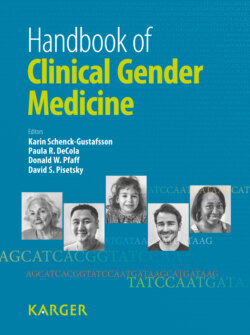Читать книгу Handbook of Clinical Gender Medicine - Группа авторов - Страница 42
На сайте Литреса книга снята с продажи.
What Is Fetal Programming?
ОглавлениеModern obstetrics has seen dramatic changes in the past decades. We have learned to observe the unborn in utero, to diagnose a variety of pathologies, and to treat some of them in utero. The fetus has become a patient and modern obstetrics has matured into feto-maternal medicine. The latest development is the advent of the new concept of ‘fetal programming’ which is based on the understanding that the intrauterine environment can impose postgenomic changes that can have far reaching consequences on health and wellbeing which can affect the individual in adulthood as well as subsequent generations. Understanding the concept of fetal programming requires the understanding of epigenetics, which in essence is the nonmutational manipulation of genes without affecting their basic structure. While epigenetic modifications, by definition, do not change the DNA sequence per se, they may cause permanent modifications of the genome by changing the methylation of DNA or through some other similar processes. Gluckman and Hansen [1] have discussed the concept of ‘developmental plasticity’ which is based on the notion that irreversible epigenetic changes due to a specific environment may lead to the development of different phenotypes from a single genotype. This is also one of the reasons why genotypically similar siblings or monozygotic twin pregnancies can be rather different phenotypically, depending on the expression of their respective genome. Thus, eventually, it is not the genome which exclusively governs our present and future but how the genome is expressed, and this can be influenced by the intra-and extrauterine environment and may therefore also be to a considerable extent under our control. Fetal programming may create predisposition factors for adult disease and is also crucial for behavioral and cognitive normalcy or deviation thereof. The importance of fetal programming cannot be overstated. Currently, much scientific effort is being invested to gather more hard evidence on this fascinating topic. Consider Project VIVA (http://www.dacp.org/viva/index.html), an NIH-and CDC-sponsored pioneering longitudinal cohort study which is following over 2,500 children starting in their intrauterine life. Since September 2008, over 50 studies have been published by the group, in addition to numerous book chapters and editorials. An even more monumental longitudinal study was initiated in 2003, namely ‘The National Children’s Study’ (http://www.nationalchildrensstudy.gov/Pages/default.aspx). This study aims to enroll 100,000 American women before and during pregnancy and to examine the effects of the environment and genetics on the growth, development, and health of offspring from before birth until the age of 21. Interagency and congressional funding of the study during the past decade has exceeded USD 600 million.
